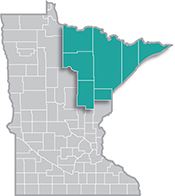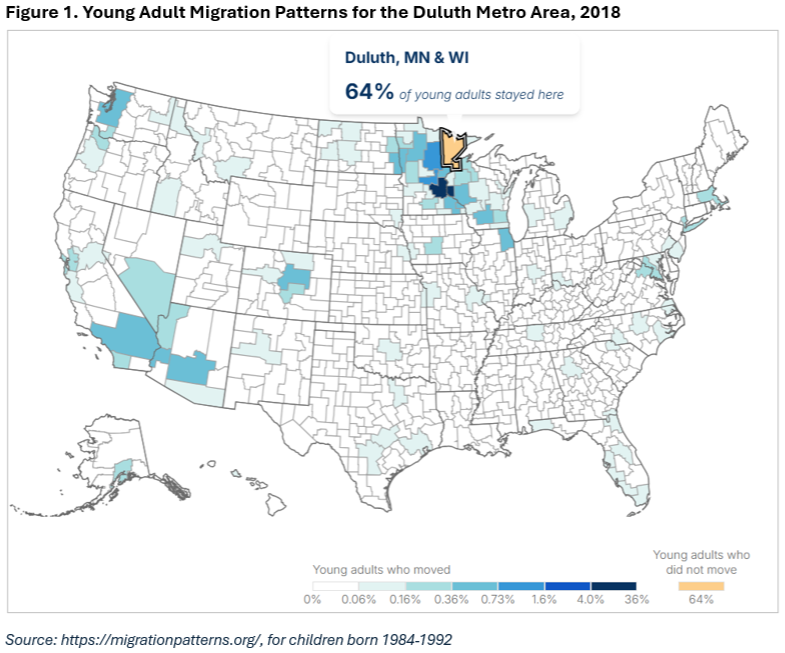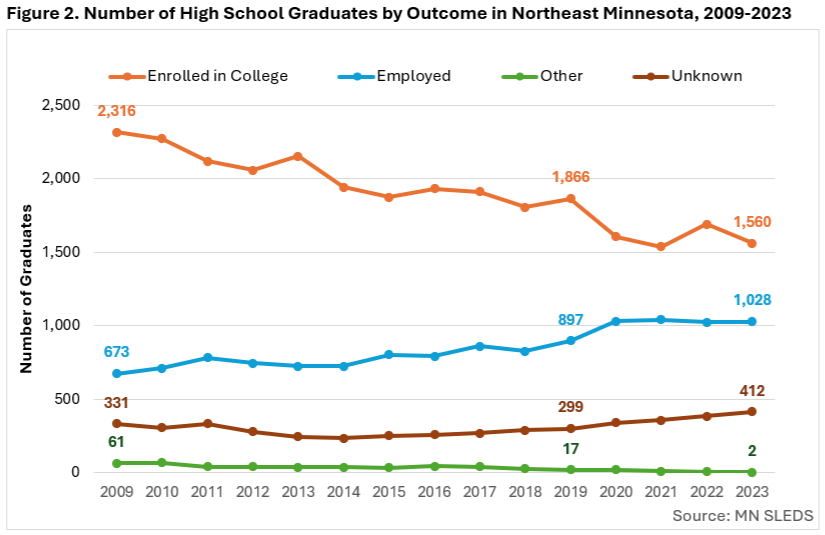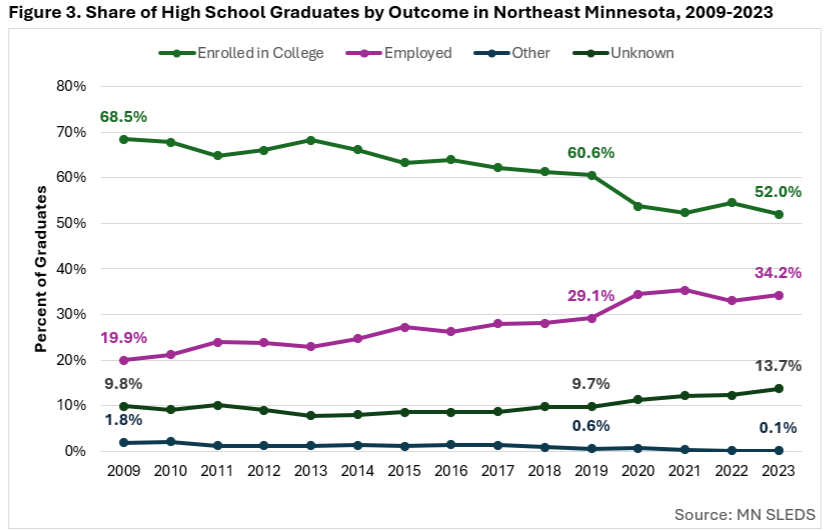 Home to the state's second-largest metro, the Northeast Region has a strong industrial sector, tied largely to the area's abundant natural resources.
Home to the state's second-largest metro, the Northeast Region has a strong industrial sector, tied largely to the area's abundant natural resources.
Most of the manufacturing base centers on mining and forest products industries. More than half of the sector's employment is in paper and machinery manufacturing.
Want the freshest data delivered by email? Subscribe to our regional newsletters.
A Regional Reality Check of Migration and Post-High School Graduation Trends
7/3/2025 11:08:05 AM
Carson Gorecki
The closing of the school year provides both an opportunity to look forward and to reflect. As graduates from high schools, colleges and universities in our region enter their summers, local employers and workforce development professionals ask themselves a set of perennial questions:
These are important questions! After all, our students are a critical part of our labor force in the future. Young talent is crucial for the regeneration and sustainability of the regional workforce. This is especially true in an area like Northeast Minnesota that is experiencing an aging workforce and the recent or impending retirement of a significant number of Baby Boomers. The general perception, for Northeast Minnesota and many rural areas, is that young people are more likely to leave these communities than to stay. So, what do the numbers say? Let's take a look.
It is certainly true that Northeast has fewer young people than it did a generation ago. However, this is not entirely due to the out-migration of those young people. A massive component is demographic change: falling birthrates and an overall aging population. We as a region are not having as many babies as we did a couple decades ago. The under 25 population in Northeast Minnesota fell 9.4% over two and a half decades, and that decline is expected to continue.
Large demographic shifts such as the ones being experienced by Northeast render migration an even more important variable in ensuring population stability or growth. A project by the U.S. Census Bureau and others the tracked migration patterns of a cohort of Millennials across the country. To do this, they counted where young people were when they were 16 and then compared that to where they were living when they turned 26.
By this measure, 64% of people that were living in the Duluth metro area when they were 16 were also living there as 26-year-olds (see Figure 1). Some may have stayed, but some of these young people may also have left and then returned; such boomerang migration is also deemed a success by workforce and economic developers. According to research by the Federal Reserve Bank of Cleveland, boomerang migration plays an above-average role in the populations of rural and small metro areas in Minnesota.
The young people leaving rural communities do not always opt for large metros like the Twin Cities. Of the 36% of 16 to 26-year-olds that chose to move away from the Duluth metro, about one-third landed in the Twin Cities metro and about a quarter opted for smaller metros or non-urban areas in Minnesota. The remainder ended up in other states, mostly in larger metros like Denver, Chicago or Seattle, but also in smaller metros or non-metro areas like Eau Claire, Wisconsin or Fargo, North Dakota.
The shares of young people staying are not as high for other areas in the region. The Brainerd commuting zone, which includes Itasca County, retained 52% of 16- to 26-year-olds, Koochiching County retained 49% and only 37% of young adults in Cook County chose to stay. These datapoints are most representative of the Millennial generation, but the data also indicate that there has not been much change in these migration patterns over time.

Another piece of the young people puzzle is parsing what high school students do upon graduation, a pivotal transition point in young peoples' lives. The Statewide Longitudinal Education Data System (SLEDS) is a great place to start. Collecting data from K-12 and beyond, SLEDS has a ton of information on student performance while in Minnesota public schools, but more importantly for our purposes here, tracks what they do after graduating high school. The most noticeable trend from SLEDS data is the declining number of graduates. In 2009, Northeast Minnesota graduated 3,381 public school students. In 2023, that number had fallen to 3,002, a decline of 11% (see Figure 2).

The second trend, which is related to the first, was a decrease in the share of graduates enrolling in college. In 2009, 68.5% (2,316) of grads form Northeast Minnesota high schools attended college the next fall (see Figure 3). By 2023, that share was 52% (1,560). At the same time, the share of graduates opting for employment alone rose from 19.9% in 2023 to 34.2%. Unlike the students that enrolled in postsecondary programs, SLEDS data does not track where graduates who opted for employment were employed in the state, just that they were employed somewhere in the state. Given the local patterns and connections of labor markets, many of these graduates were likely employed close to home. There was also a rise in the share and number of graduates with unknown statuses.

Of the 1,560 grads in the region that opted for college in the fall of 2023, 879 (56.3%) stayed in Northeast Minnesota or Northwest Wisconsin. The share of graduates staying in-region also fell over time. In 2009, 63.8% enrolled at area colleges and in 2019 the share was 59.7%. Of course, not all the students enrolled in postsecondary schools in Northeast Minnesota or Northwest Wisconsin are from the region. An estimated 3,500 Minnesota high school graduates enrolled at schools in the region in 2023, meaning over 2,600 came from elsewhere to study. This total was also down from previous years. In 2009, 5,055 high school grads chose the region for college, but by 2019, just 4,331 outside students did so.
Still, the 8.5% of Minnesota high school graduates that enrolled at schools in Northeast Minnesota was larger than both the 5.6% of the state's total population living in the region as well as the 6% of the state's 15 to 24-year-olds that called the area home. This is all to say, Northeast Minnesota remains an above-average attractor of postsecondary students.
While there are young people that leave Northeast Minnesota, they have done so at lower rates than other regions. And the presence of five successful, diverse postsecondary institutions in the region (and two more next door in Superior) not only attracts young people from outside the region but retains many that grew up here as well. In doing so, these schools create unique and valuable workforce development and talent attraction opportunities for the region.
For more information about student trends in Northeast Minnesota, contact Carson Gorecki at Carson.Gorecki@state.mn.us.